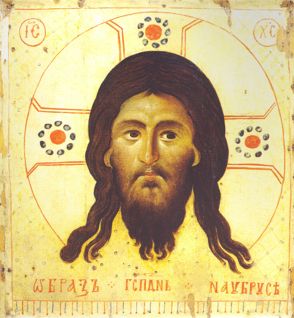 Description:
Description:
Among numerous Serbian icons of Middle Ages, which could be found in church treasuries of the East and West, the oldest one, and not very familiar to us, is the icon of Christ's face on the handkerchief (Mandylion) that has been kept in French town of Laon for more then seven centuries. The icon was brought to France in 1249. A nobleman Jacques Pantaleon de Troyes (later Pope Urban IV, from 1261 to 1264) sent the icon, which had probably been kept in one of the Vatican's treasuries, as a present to his sister Sybille, abbess of the Cistercian convent of Montreuil-les-Dames, La Neuville near Laon. (It is well known that Serbian court, since the time of the king Stefan Prvovencani, has often offered presents to Rome). After the French Revolution, the icon was brought to the cathedral of the neighboring town of Laon in 1795, and in 1807 it was placed on the altar as some sort of city Palladium. According to the custom of Western Church the icon has its confraternity, and the citizens emphasize that their town, thanks to the icon, has been spared protected from pestilence and war disasters for centuries. At the beginning of this year a grandiose and impressive exhibition of Byzantine fine arts has been opened in Metropolitan Museum, New York, where the artistic objects from Serbia have an important place. This icon is also among the exhibits but the commentary that has been given in the otherwise comprehensive and luxurious catalogue is somewhat inadequate. The main information that the icon is by its origin and style related to the Serbian arts of early 13th century has not been mentioned. A few decades ago, Prof. Radojicic, our and worldly known Byzantinist, has emphasized its importance while referring to it. The style of this icon can be directly connected to the style of the frescos in the church of the Mother of God in Studenica, where it has been displayed three times. In the narthex of the king Radoslav there is one of painted Mandalyions with background ornament identical to the one on the icon. Jesus' face is softly modeled, without clearly defined shadows, and painted in rosy ocher; the features of slightly flatten nose and regularly shaped lips truly imitate the style of the best paintings in Studenica. The inscription under the face is a Serbian version with the ductus of the letters found in the inscriptions of the frescoes from that period. Iconographically this type of icon has been taken up from Byzantine and in Serbian fine arts has been known from the earliest monuments. It is obligatorily painted on the tambour supporting the dome. This simple representation of Jesus' face presents a visual replacement for a very complex content of the Incarnation of Jesus Christ as God and man.
Ljubomir Vujaklija